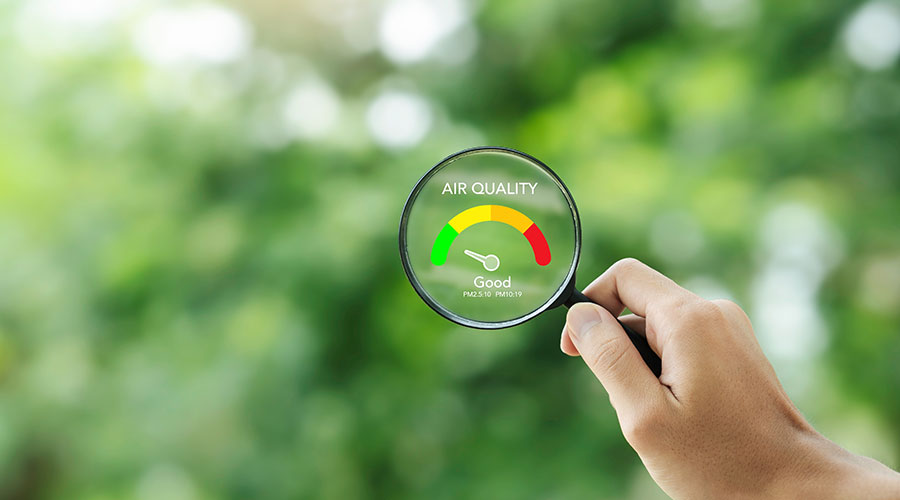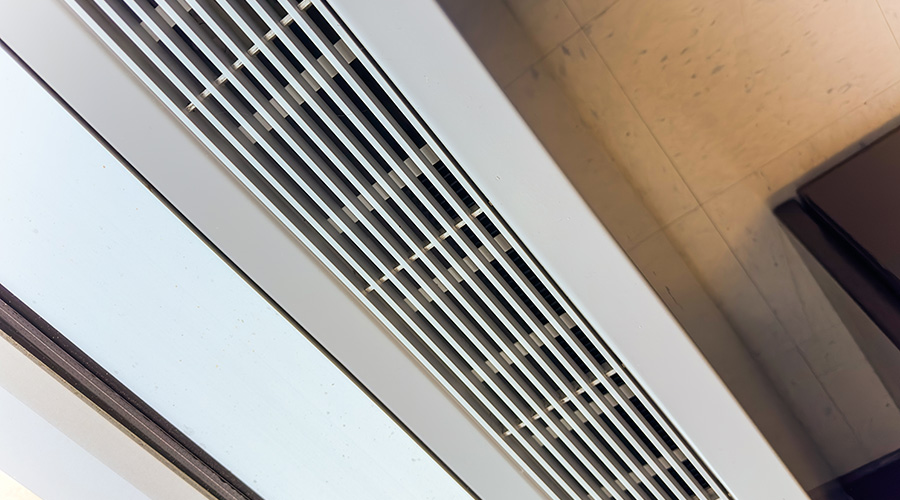Stopping Mold Before It Starts
Removing mold from buildings is costly and time consuming.
Preventing it is cheaper and smarter
Recent reports of outbreaks of mold in institutional and commercial facilities have prompted a growing number of maintenance and engineering managers to take a closer look at their facilities to determine if they are at risk. Many are focusing on their facilities’ HVAC systems, which contain ideal conditions for mold growth, as well as for its dispersal throughout a facility.
Small amounts of mold exist all around, including on the surface of most building materials. Mold spores are found in both outside air and conditioned building air. In low concentrations, they go unnoticed and pose no threat. But when conditions are right, mold can grow and spread rapidly.
Besides causing discoloration and odors, mold can cause concern about health. It has been implicated in a range of health problems, including allergies and asthma. The growth of mold and other microorganisms is thought to be a leading contributor to sick building syndrome.
Every year, organizations spend millions of dollars on remediation of building systems and components to correct damage resulting from the uncontrolled mold growth — a necessary step to protect building occupants and contents. But it is far more cost-effective to take steps to prevent the growth of mold in the first place.
Mold Growth Formula
Mold growth requires four ingredients: organic nutrients, moisture, a growth surface and darkness. All four ingredients are found in most building HVAC systems.
Organic nutrients exist in HVAC systems in the form of dirt, which collects on coil surfaces, accumulates on condensate pans, becomes embedded in duct liners, or builds up in certain duct areas, such as in corners and transitions with minimal airflow.
In turn, dirt can absorb moisture from the air, adding the second ingredient necessary for mold growth. And with air temperatures in the ductwork ranging from 40 degrees to 100 degrees, conditions are ideal for the growth and distribution of mold.
Taking the Offensive
Since mold and spores that develop into mold are everywhere, managers need to develop an aggressive program to prevent mold growth — one that starts with selecting the right equipment and continues with regular, planned maintenance.
Since moisture is one requirement for mold formation, eliminating moisture from an HVAC system needs to be a major consideration when selecting system components. For example, cooling coils generate large volumes of water in the form of condensate. In the past, facilities installed flat pans under coils to collect condensate. But flat pans allow water to stagnate.
Stagnant water combined with the dirt washed from the cooling coil creates an ideal environment for mold growth. And if growth is sufficient, it can clog the condensate drain line, causing condensate to overflow and create more wet surfaces that perpetuates mold growth.
To ensure condensate is effectively carried away from the coil and doesn’t stagnate in the condensate pan, new pans are double-sloped to assure positive drainage to the drain line. New pans are also made from materials that resist corrosion, a common problem with older metal pans.
When selecting and installing new HVAC equipment, managers should verify that the condensate pan is double-sloped, and make certain the pan is installed level and that the drain line is trapped and properly connected to a building drain.
Finally, trapping the drain line will help prevent drawing building sewer gas into the HVAC system. If an existing system has a history of condensate overflow or mold growth in the condensate pan, or if the pan is badly deteriorated, managers should look to upgrade the existing pan to one of the double-sloped designs.
Ductwork Decisions
Another area where mold is commonly found in HVAC systems is within distribution ductwork. In the past, it was common to install ductwork with an interior lining, which provided both thermal and acoustical insulation.
But in many cases, the lining’s surface was rough and porous, which served to trap both dirt and moisture, creating an ideal environment for mold growth. Even worse, the lining was almost impossible to clean.
Today, the accepted practice is to use double-wall ductwork with a nonporous, smooth interior surface that resists trapping dirt and moisture. Maintenance and engineering managers should verify that double-wall ductwork is specified for all new construction and building renovations.
While replacing ductwork in an existing facility is expensive, replacing it with double-wall ductwork might be the only solution if existing lined ductwork is badly contaminated with dirt and mold.
Managers also should consider using ultraviolet (UV) light to kill mold and other microorganisms within an HVAC system. Installed on the distribution side of the cooling coil, specially designed light fixtures emit UV light in the 200-230 nm wavelength range. UV units are inexpensive to operate and offer long service lives, while effectively reducing the levels of mold and microorganisms introduced into the conditioned space.
UV light can damage skin and eyes, so systems using these lights must be equipped with safety interlocks to ensure that lights are turned off before technicians open any nearby access panels.
Operating Practices
While equipment selection is an important element in reducing mold in HVAC systems, it is equally important that managers ensure that technicians properly operate and maintain systems and components.
For example, one common response to occupant complaints about stuffy space conditions is to increase the system’s airflow. But cooling coils are designed to operate within a fairly narrow range of airflow, so once that rate is exceeded, water that normally drains to the condensate pan instead can be carried from the coil by the airflow, saturating the interior of ductwork and creating an environment for mold growth.
A common but often overlooked source of microbiological contaminants is a building’s cooling tower. With its warm, moist airflow, a cooling tower is an ideal environment for the growth of mold and a range of other microbiological organisms. If a cooling tower is located too near a building’s fresh-air intake, warm, moist air loaded with contaminants can be drawn into a building’s HVAC system.
To minimize contamination from cooling towers, managers should ensure that towers are located well away from fresh air intakes. Also, facilities should consider implementing a comprehensive water treatment program for cooling towers to minimize microbiological organism growth within the cooling tower.
By taking these preventive steps, it is possible to avoid having to implement costly and disruptive measures in order to rid a facility’s HVAC system of mold.
Mold Prevention: Maintenance Matters
Well-designed installations and good operating practices will help reduce the chances of mold contaminating HVAC systems, but these steps are not enough. Accidents occur. Equipment breaks down. Systems go out of calibration.
To minimize the impact of these problems, systems must be inspected regularly. Regular inspections require that systems be accessible so they are more likely to be inspected and maintained than those that are difficult to access.
Hinged doors and access panels should be installed at central equipment, providing easier access to all equipment, condensate pans and ductwork immediately downstream from the equipment. Also, access panels should be provided throughout the distribution system where dirt is likely to accumulate, such as at turns in the ductwork and before and after humidifiers, fire dampers and other devices that restrict the flow of air.
Each week, technicians should inspect the condition and operation of all central equipment, paying particular attention to the flow of water from condensate pans while air conditioning equipment is operating. Condensate pans should be checked for standing water and dirt accumulation.
Once a year, technicians should clean and closely inspect condensate pans for leaks and deterioration. Humidifiers and ductwork downstream should be inspected for moisture weekly when systems are operating.
Technicians should inspect ductwork interiors annually for moisture and dirt accumulation. If they find dirt, that portion of the ductwork should be cleaned. If they find moisture, they must identify and correct the source of the moisture. Then that portion of the ductwork should be cleaned as needed.
Fan coil and other terminal units should be inspected once a year, and their condensate pans should be cleaned and inspected for deterioration. Make certain that all condensate line connections are watertight. Any signs of flooding or water damage must be investigated.
Finally, a simple walkthrough of the facility can help to identify potential problems. Inspectors should look at diffusers for accumulated dirt or even mold growth. Stained ceiling tiles might indicate roofing or mechanical system leaks that will contribute to mold growth.
Inspectors also should note temperature and humidity changes between different building zones. Investigate unusual odors that might be related to the growth of mold or other microorganisms.
Finally, inspectors should conduct walkthroughs at least once during the heating season and again during the air conditioning season.
|
Related Topics:











